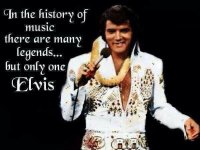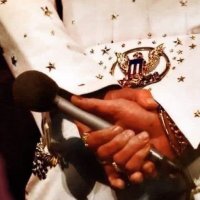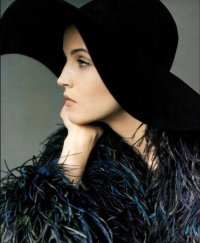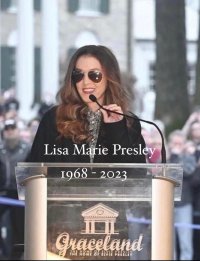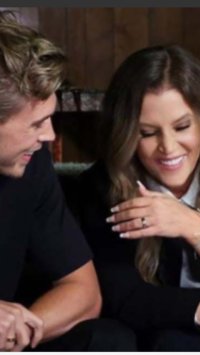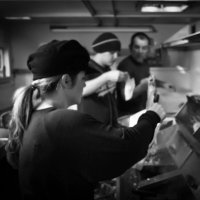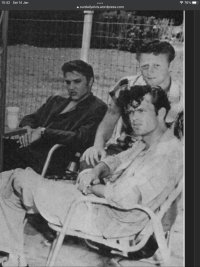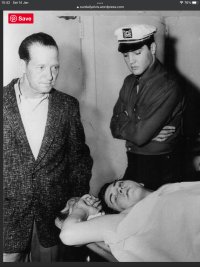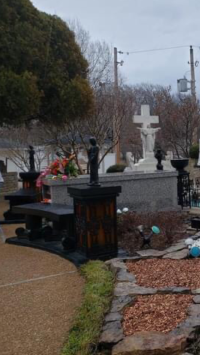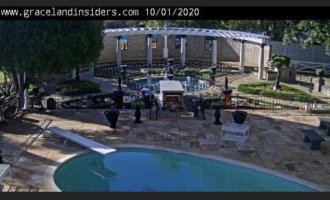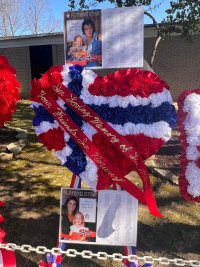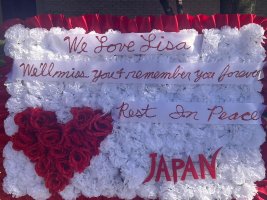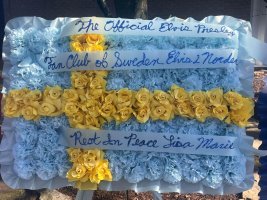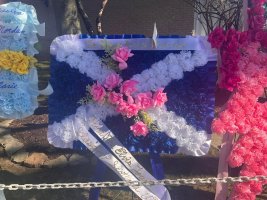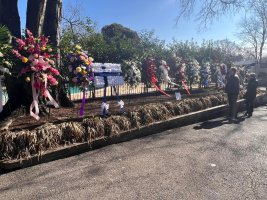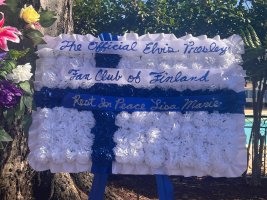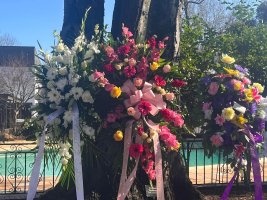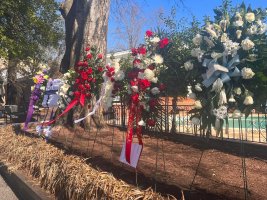You are using an out of date browser. It may not display this or other websites correctly.
You should upgrade or use an alternative browser.
You should upgrade or use an alternative browser.
The Elvis Presley Memorial Thread
- Thread starter caitlin1214
- Start date
More options
Who Replied?I recall when Vernon was granted permission in 1977 to rebury Elvis and his mother Gladys at Graceland the permission was for a maximum of 6 bodies - Lisa will make that 6 - Elvis Vernon Gladys Minnie Mae ( Elvis paternal grandmother) and Ben are already there
Ben was laid to rest opposite the other graves in a marble kind of tomb above ground. The fountain is in between the two grave areas
Bens grave has two black statues either side of it -I wonder if Lisa will be laid into the same tomb? It is similar to how the Queen and Prince Philip are buried at Windsor and I can’t see how there would be room for another grave in that area now - I’ve never see anything like this above the ground to be honest - the other 4 graves just have a large flat memorial tablet laid flat on the ground
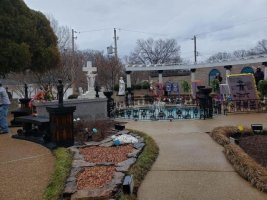
Bens grave has two black statues either side of it -I wonder if Lisa will be laid into the same tomb? It is similar to how the Queen and Prince Philip are buried at Windsor and I can’t see how there would be room for another grave in that area now - I’ve never see anything like this above the ground to be honest - the other 4 graves just have a large flat memorial tablet laid flat on the ground

Last edited:
A really nice feature about the Aloha from Hawaii concert 50 years ago, appearing in the Honolulu Star Advertiser today, 1/20/23.
And no, I didn't attend the concert.
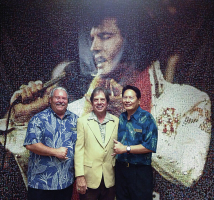
COURTESY MARIA BERMUNDO CASTRO
Walter Figueira, left, Ralph Vares and Dennis Ling, in front of a photo from “Aloha From Hawaii,” were ushers at the Elvis Presley concert 50 years ago.
The 50th anniversary of the Elvis concert “Aloha From Hawaii” was Saturday. The concert was the first ever to be broadcast worldwide. An estimated 1.5 billion fans in 36 countries watched the 90-minute show.
It was beamed by satellite to Japan, Australia, South Korea, New Zealand, the Philippines, Thailand and South Vietnam, where it was shown live in prime time.
Fans in Europe saw the show via satellite delay, while it was recorded for a later broadcast in Hawaii and on the mainland.
The concert was a benefit for the Kui Lee Cancer Research Fund and raised over $500,000 (in today’s dollars).
Newspaper columnist Eddie Sherman was the man behind the whole idea. In 1973, Sherman discovered he had Bell’s palsy, and the right side of his face was paralyzed for some time.
“During my treatment I became extremely friendly with my neurosurgeon, Dr. Stanley Batkin. This brilliant man is devoting most of his time and energy to cancer research at the University of Hawaii.”
But UH lacked money to apply for national grants, Sherman learned. “When he told me about it, and after meeting with the dean of medicine, Dr. Terrance Rogers, I vowed somehow to try and help.”
So, Sherman established the Kui Lee Cancer Research Fund, named in honor of Hawaii’s best-known contemporary singer-composer, a victim of cancer. Lee had died seven years earlier in 1966 at the age of 34.
Sherman turned to Elvis’ manager, Col. Tom Parker. “Because you and Elvis will be appearing in Hawaii, I thought I would ask you to consider in some way a contribution to the Kui Lee Cancer Research Fund from your shows.”
“Presley and Parker agreed,” Sherman said. “They undoubtedly have a soft spot for Hawaii, previously raising $62,000 for the building of the USS Arizona Memorial at Pearl Harbor.”
Presley had been a constant vacationer in these parts. He filmed three of his films in Hawaii: “Blue Hawaii,” “Girls! Girls! Girls!” and “Paradise, Hawaiian Style.”
Plus, Elvis had recorded Kui Lee’s biggest hit, “I’ll Remember You,” and it was a regular part of his concerts. “Everybody loves that song,” Presley explained. “I do it everywhere.” His recording of it also appeared in his 1966 movie “Spinout.”
‘I’ll Remember You’
Kui Lee wrote the song in 1964 for his wife, Nani, who had left him to go live with her sister in New Jersey. They had a tempestuous relationship, and it wasn’t the first time she had left him. But it was the last.
One night he brought the song to Don Ho. He had written it in just four hours.
Lee’s songs had made Don Ho famous. Some of his hits included “Lahainaluna,” “One Paddle, Two Paddle,” “Suck ’Em Up” and “Ain’t No Big Thing.”
He asked Don to arrange it. “I sat up all night with him, absorbing the essence of what he was writing about,” Ho recalled. “The next day, I wrote down the arrangement of the song.
“That night, I said that this was written by a friend of mine. At that time, he had cancer in his throat. I sang it with the Allis. I’ll never forget that night. At that moment everybody had tears in their eyes.
“Then I introduced Kui. He came on stage and he sang it. Then everybody really had tears.”
The song was soon recorded by Don Ho, Andy Williams, Tony Bennett, Herb Alpert & the Tijuana Brass, Glenn Yarbrough, Elvis and many others.
Newsman Wayne Harada said “I’ll Remember You” was the hottest tune to come out of the islands since Harry Owens wrote “Sweet Leilani” back in the 1930s.
It rivaled Andy Williams’ “The Hawaiian Wedding Song” and Elvis Presley’s “Blue Hawaii.”
Harada said he had never seen so many artists rush to record a Hawaiian song like “I’ll Remember You.”
Col. Tom Parker
Elvis’ manager, Parker, had a problem, former Poi Boy Ron Jacobs told me. “He wasn’t really a colonel. It was an honorific he bestowed on himself. And he wasn’t from the South, like everyone thought.
“He was from the Netherlands and was in the U.S. without a passport. He couldn’t leave the country, so Elvis couldn’t perform in Asia.”
Worldwide audience
George Parkhill, who produced the event, says Parker had an idea: One concert. A billion and a half viewers. “He came to me one day and asked if the concert was possible.”
“Could we beam it by satellite to be seen live in prime time in Asia?” he asked.
“We sat down and in about one hour developed it,” Parkhill said. “We have to do it after midnight in Hawaii, though, he said, but it could be done.”
“Elvis in the only one in the world who could command a worldwide audience in 1973.”
‘Aloha From Hawaii’
I heard from three employees of the Neal Blaisdell Center, which at the time was called the Honolulu International Center. Dennis Ling said they worked at Elvis’ concert and still work at the NBC.
Elvis put on two shows, Ling said. One was a rehearsal. Ling remembers Parker spoke with a foreign accent (as opposed to a Southern drawl). “He was a short, pudgy, sunburned guy in a baseball cap checking everything out.”
He also remembers: “We had to report to work late that night because the concert started after midnight.
“People were offering us big tips to be seated downstairs,” Ling said, “which was tempting to us poor students, but we were prohibited from taking them. The show was sold out and packed with seats in places that wouldn’t pass the fire code today.
“The stage was so large that it blocked the whole back of the seating area behind it.”
Walter Figueira remembers, “We had to work for free because it was a benefit for the Kui Lee cancer fund, but we were all excited and willing to do so.”
“Two tickets were given to the ushers and staff of the HIC, so we were able to have family members see the show.”
Ralph Vares recalls hula dancers on the concourse, outside the center, and one of them was Sweetie Moffatt, promoter Tom Moffatt’s wife.
‘All shook up’
Vares said that when Elvis first took the stage, the crowd screamed so loudly that he got “all shook up.”
The show began at 12:30 a.m. so it would be seen during prime time in Japan, Australia, New Zealand, South Korea, the Philippines, South Vietnam and Thailand. It was broadcast at a later date in Hawaii and on the mainland.
The Honolulu Star-Bulletin reported: “One side of the stage was layered with long, wide sheets of aluminum foil which acted as a giant mirror. The rear of the stage was curtained with a thin, black fabric, sporting yellow and orange designs.
“Behind that was an illuminated silhouette of Presley and the name ‘Elvis’ spelled out in bright lights.
“He walked out in a tight, bejeweled jumpsuit to the thundering theme from the film ‘2001.’ Then he started rocking to ‘C.C. Rider.’”
Elvis was backed by his usual musicians, two singing groups and an orchestra — over 30 people in all.
Fans presented him with over a half-dozen lei during the telecast, but two would-be lei presenters were Kui Lee’s daughters, who tried but failed to get his attention.
Elvis spoke of the Kui Lee Cancer Fund and sang Lee’s “I’ll Remember You.” Other songs included “Kuuipo,” “The Hawaiian Wedding song,” “Hound Dog,” “Blue Suede Shoes,” “My Way,” “Burning Love,” “Fever,” “Welcome to My World” and a medley of “Dixie,” “Battle Hymn of the Republic” and “All My Troubles, Lord.”
“Toward the end of the show, sweat was dripping from his brow and his full, lengthy hair was tousled,” the Star-Bulletin wrote. “But his showmanship never faltered. He donned a cape, sang ‘Can’t Help Falling in Love With You,’ and called it a night.” The crowd rose to give him a thunderous standing ovation.
Epilogue
“Elvis: Aloha From Hawaii” was broadcast on the mainland and in Hawaii three months later in April 1973. Elvis released a long-playing record of the concert. It was his last No. 1-charting album.
Presley died four years later in 1977 at 45 years of age. His daughter, Lisa Marie, born in 1968, died last week, Jan. 12, at age 54.
Eddie Sherman secured the rights to Kui Lee’s life, and Leonard Freeman, who created “Hawaii Five-O,” planned to turn it into a movie. Elvis was interested in starring in it, but the project failed to get off the ground.
Eddie Sherman felt that the “Aloha From Hawaii” fundraising concert was one of his biggest achievements. He died in 2013 at age 89.
And no, I didn't attend the concert.

Rearview Mirror: Elvis’ ‘Aloha From Hawaii’ concert was 50 years ago
By Bob Sigall, Special to the Star-Advertiser
COURTESY MARIA BERMUNDO CASTRO
Walter Figueira, left, Ralph Vares and Dennis Ling, in front of a photo from “Aloha From Hawaii,” were ushers at the Elvis Presley concert 50 years ago.
The 50th anniversary of the Elvis concert “Aloha From Hawaii” was Saturday. The concert was the first ever to be broadcast worldwide. An estimated 1.5 billion fans in 36 countries watched the 90-minute show.
It was beamed by satellite to Japan, Australia, South Korea, New Zealand, the Philippines, Thailand and South Vietnam, where it was shown live in prime time.
Fans in Europe saw the show via satellite delay, while it was recorded for a later broadcast in Hawaii and on the mainland.
The concert was a benefit for the Kui Lee Cancer Research Fund and raised over $500,000 (in today’s dollars).
Newspaper columnist Eddie Sherman was the man behind the whole idea. In 1973, Sherman discovered he had Bell’s palsy, and the right side of his face was paralyzed for some time.
“During my treatment I became extremely friendly with my neurosurgeon, Dr. Stanley Batkin. This brilliant man is devoting most of his time and energy to cancer research at the University of Hawaii.”
But UH lacked money to apply for national grants, Sherman learned. “When he told me about it, and after meeting with the dean of medicine, Dr. Terrance Rogers, I vowed somehow to try and help.”
So, Sherman established the Kui Lee Cancer Research Fund, named in honor of Hawaii’s best-known contemporary singer-composer, a victim of cancer. Lee had died seven years earlier in 1966 at the age of 34.
Sherman turned to Elvis’ manager, Col. Tom Parker. “Because you and Elvis will be appearing in Hawaii, I thought I would ask you to consider in some way a contribution to the Kui Lee Cancer Research Fund from your shows.”
“Presley and Parker agreed,” Sherman said. “They undoubtedly have a soft spot for Hawaii, previously raising $62,000 for the building of the USS Arizona Memorial at Pearl Harbor.”
Presley had been a constant vacationer in these parts. He filmed three of his films in Hawaii: “Blue Hawaii,” “Girls! Girls! Girls!” and “Paradise, Hawaiian Style.”
Plus, Elvis had recorded Kui Lee’s biggest hit, “I’ll Remember You,” and it was a regular part of his concerts. “Everybody loves that song,” Presley explained. “I do it everywhere.” His recording of it also appeared in his 1966 movie “Spinout.”
‘I’ll Remember You’
Kui Lee wrote the song in 1964 for his wife, Nani, who had left him to go live with her sister in New Jersey. They had a tempestuous relationship, and it wasn’t the first time she had left him. But it was the last.
One night he brought the song to Don Ho. He had written it in just four hours.
Lee’s songs had made Don Ho famous. Some of his hits included “Lahainaluna,” “One Paddle, Two Paddle,” “Suck ’Em Up” and “Ain’t No Big Thing.”
He asked Don to arrange it. “I sat up all night with him, absorbing the essence of what he was writing about,” Ho recalled. “The next day, I wrote down the arrangement of the song.
“That night, I said that this was written by a friend of mine. At that time, he had cancer in his throat. I sang it with the Allis. I’ll never forget that night. At that moment everybody had tears in their eyes.
“Then I introduced Kui. He came on stage and he sang it. Then everybody really had tears.”
The song was soon recorded by Don Ho, Andy Williams, Tony Bennett, Herb Alpert & the Tijuana Brass, Glenn Yarbrough, Elvis and many others.
Newsman Wayne Harada said “I’ll Remember You” was the hottest tune to come out of the islands since Harry Owens wrote “Sweet Leilani” back in the 1930s.
It rivaled Andy Williams’ “The Hawaiian Wedding Song” and Elvis Presley’s “Blue Hawaii.”
Harada said he had never seen so many artists rush to record a Hawaiian song like “I’ll Remember You.”
Col. Tom Parker
Elvis’ manager, Parker, had a problem, former Poi Boy Ron Jacobs told me. “He wasn’t really a colonel. It was an honorific he bestowed on himself. And he wasn’t from the South, like everyone thought.
“He was from the Netherlands and was in the U.S. without a passport. He couldn’t leave the country, so Elvis couldn’t perform in Asia.”
Worldwide audience
George Parkhill, who produced the event, says Parker had an idea: One concert. A billion and a half viewers. “He came to me one day and asked if the concert was possible.”
“Could we beam it by satellite to be seen live in prime time in Asia?” he asked.
“We sat down and in about one hour developed it,” Parkhill said. “We have to do it after midnight in Hawaii, though, he said, but it could be done.”
“Elvis in the only one in the world who could command a worldwide audience in 1973.”
‘Aloha From Hawaii’
I heard from three employees of the Neal Blaisdell Center, which at the time was called the Honolulu International Center. Dennis Ling said they worked at Elvis’ concert and still work at the NBC.
Elvis put on two shows, Ling said. One was a rehearsal. Ling remembers Parker spoke with a foreign accent (as opposed to a Southern drawl). “He was a short, pudgy, sunburned guy in a baseball cap checking everything out.”
He also remembers: “We had to report to work late that night because the concert started after midnight.
“People were offering us big tips to be seated downstairs,” Ling said, “which was tempting to us poor students, but we were prohibited from taking them. The show was sold out and packed with seats in places that wouldn’t pass the fire code today.
“The stage was so large that it blocked the whole back of the seating area behind it.”
Walter Figueira remembers, “We had to work for free because it was a benefit for the Kui Lee cancer fund, but we were all excited and willing to do so.”
“Two tickets were given to the ushers and staff of the HIC, so we were able to have family members see the show.”
Ralph Vares recalls hula dancers on the concourse, outside the center, and one of them was Sweetie Moffatt, promoter Tom Moffatt’s wife.
‘All shook up’
Vares said that when Elvis first took the stage, the crowd screamed so loudly that he got “all shook up.”
The show began at 12:30 a.m. so it would be seen during prime time in Japan, Australia, New Zealand, South Korea, the Philippines, South Vietnam and Thailand. It was broadcast at a later date in Hawaii and on the mainland.
The Honolulu Star-Bulletin reported: “One side of the stage was layered with long, wide sheets of aluminum foil which acted as a giant mirror. The rear of the stage was curtained with a thin, black fabric, sporting yellow and orange designs.
“Behind that was an illuminated silhouette of Presley and the name ‘Elvis’ spelled out in bright lights.
“He walked out in a tight, bejeweled jumpsuit to the thundering theme from the film ‘2001.’ Then he started rocking to ‘C.C. Rider.’”
Elvis was backed by his usual musicians, two singing groups and an orchestra — over 30 people in all.
Fans presented him with over a half-dozen lei during the telecast, but two would-be lei presenters were Kui Lee’s daughters, who tried but failed to get his attention.
Elvis spoke of the Kui Lee Cancer Fund and sang Lee’s “I’ll Remember You.” Other songs included “Kuuipo,” “The Hawaiian Wedding song,” “Hound Dog,” “Blue Suede Shoes,” “My Way,” “Burning Love,” “Fever,” “Welcome to My World” and a medley of “Dixie,” “Battle Hymn of the Republic” and “All My Troubles, Lord.”
“Toward the end of the show, sweat was dripping from his brow and his full, lengthy hair was tousled,” the Star-Bulletin wrote. “But his showmanship never faltered. He donned a cape, sang ‘Can’t Help Falling in Love With You,’ and called it a night.” The crowd rose to give him a thunderous standing ovation.
Epilogue
“Elvis: Aloha From Hawaii” was broadcast on the mainland and in Hawaii three months later in April 1973. Elvis released a long-playing record of the concert. It was his last No. 1-charting album.
Presley died four years later in 1977 at 45 years of age. His daughter, Lisa Marie, born in 1968, died last week, Jan. 12, at age 54.
Eddie Sherman secured the rights to Kui Lee’s life, and Leonard Freeman, who created “Hawaii Five-O,” planned to turn it into a movie. Elvis was interested in starring in it, but the project failed to get off the ground.
Eddie Sherman felt that the “Aloha From Hawaii” fundraising concert was one of his biggest achievements. He died in 2013 at age 89.
People in Hawaii continue to remember Kui Lee and Elvis together, and the song is so beautiful
I'll Remember You - Elvis
I'll Remember You - Elvis
Ben has now been moved to the side slightly and Lisa is alongside him in an identical tomb at peace at last
Register on TPF! This sidebar then disappears and there are less ads!

